#Pittsburgh Zoo Times
Explore tagged Tumblr posts
Text
Pittsburgh Zoo & PPG Aquarium: A Wildlife Wonderland
The Pittsburgh Zoo & PPG Aquarium is a captivating destination that combines the wonders of a zoo and an aquarium. Located in Highland Park in Pittsburgh, this renowned facility spans 77 acres of parkland and boasts an impressive collection of over 4,000 animals from 475 different species. With a rich history dating back to its opening in 1898, the Pittsburgh Zoo & PPG Aquarium has evolved into…

View On WordPress
#Is The Pittsburgh Zoo Free#pittsburgh zoo#Pittsburgh Zoo & Aquarium Photos#Pittsburgh Zoo & Aquarium Reviews#Pittsburgh Zoo & Aquarium Tickets#Pittsburgh Zoo & Aquarium Updates#Pittsburgh Zoo Accreditation#Pittsburgh Zoo And Aquarium#Pittsburgh Zoo Contact Us#Pittsburgh Zoo Encounters#Pittsburgh Zoo Entrance#Pittsburgh Zoo Hours#Pittsburgh Zoo Map#Pittsburgh Zoo Ranking#Pittsburgh Zoo Reviews#Pittsburgh Zoo Schedule#Pittsburgh Zoo Tickets#Pittsburgh Zoo Times#Pittsburgh Zoo Website#Pittsburgh Zoo.org
0 notes
Text
"Okay, and ... how many loops has it been?"
"Uh, I have no idea, I haven't really been counting, let me think for a second ... eight hundred years or so? So maybe in the region of ten thousand loops? That sounds about right."
"Holy shit. Holy shit. So you must have done everything. You must have seen everything. How many times have we had this conversation?"
"Just this once, actually."
"You must have read every book, you must speak every language, you must have seen the entire world."
"Look, I've gotta be honest with you, I actually got really comfortable in Pittsburgh. I go to the zoo on Mondays, Tuesday is rock climbing at the gym, and then I play a bunch of Civ 6."
"That ... you must be really good at it?"
"Oh, no, I have like a hundred thousand hours in the game and I'm still trash. It's fun though, which is the main thing."
"... it is?"
"I mean yeah, you have to enjoy life. I guess I could have learned a language or two, or picked up a skill, but ... eh."
"You've been in this loop for eight hundred years and you didn't pick up any skills?"
"Not really, no. I mean, let me think ... I went to piano practice a few times and wasn't really into it. I had a guitar for a bit, only got good enough to play Wonderwall."
"That is such a waste."
"See, I kind of understand that, and I know you well enough to know you'd say, like 'oh, I should go eat at every restaurant in the world, I should order every dish on every menu'. That's not me though. I like eating my Subway sandwiches. I like having a coffee with cream and sugar. Why change it up?"
"Variety? A sense of adventure?"
"Nah."
"Well then why are you talking to me now, revealing things after eight hundred years?"
"Oh, well, the Subway that I go to, the one next to my apartment, they always put a little too much mayo on my subs, and I can order without mayo, but I like a little mayo, so yeah, the sandwiches haven't really been quite exactly what I want. And you're good with people, so I figured maybe you could help me out? Like tell me what the right thing to say is?"
"..."
"If it's not too much trouble."
"You've been eating Subway sandwiches for eight hundred years and they've been putting too much mayo on."
"Yeah."
"..."
"Sorry."
"No, don't apologize, I'll help you out. Let's go."
591 notes
·
View notes
Text
Is It Ok For An Alligator To Have Tape On Their Mouth?
Alligators make pretty amazing animal ambassadors when handled safely and ethically. And it is actually pretty safe to take them out to interact with the zoo-going public (or general public in some settings), when done correctly. Many zoos and outreach organizations do an amazing job of this! Every state has different rules, but even if a state doesn't mandate that alligators be banded... well, if you're a responsible crocodilian handler, you'll band anyways. It's a huge public safety issue! Even an accidental graze against their front teeth can cause injury. See, the alligators that are used as handle-able ambassadors are pretty small, and their teeth are razor sharp. An adult gator has sharp teeth, too, as well as blunt teeth for crushing, and they also have the additional force of their jaw muscles.
Here's what it sounds like when an adult alligator pops his jaw. (Don't worry about the hissing/gaping; this is a trained and queued behavior. The stick towards the top of the inside of the mouth is triggering the bite reflex. Chester probably got lots of chicken and fish as he learned to do this.)
youtube
Skip ahead to 0:32 if you wanna skip the guest commentary.
What's more, biting is an important reflex for crocodilians. The lower jaws of crocodilians are some of the most innervated tissues in the animal kingdom; they are more sensitive than human fingertips! Even the slightest touch triggers their bite reflex, which likely is an adaptation that lets them detect changes in water pressure that signal a snack heading their way.
Here's a pretty good video about the biomechanics of crocodilian jaws:
youtube
So yeah. They need to not be able to bite for public safety. There's just too much risk involved with an unbanded alligator (or other crocodilian). Fortunately, it's easy to get a crocodilian to not bite- you just need to band its mouth!
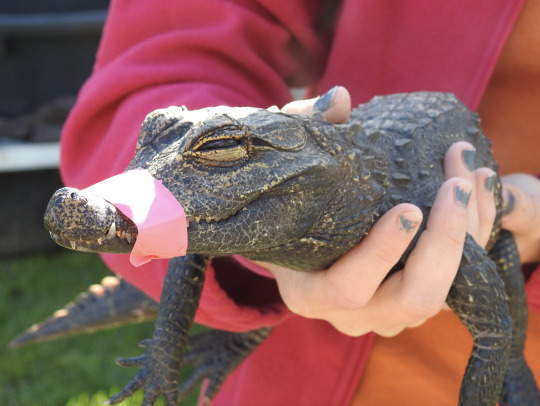
(This fella is Frodo the dwarf caiman, but the principle is the same.)
This works because while crocodilians have an extremely strong bite force (claims range from 2,000 PSI to 5,000+ PSI, but I don't have time to get into that now but someday I will probably), but not particularly strong muscles to open their mouths. Selective pressure for quickly nabbing prey in murky water where there's not a lot of visibility lead to pterygoid and adductor muscles so big, they extend into the animal's neck. But those muscles only pull the jaw closed- they don't work to open it! That's why you see people holding an alligator's mouth closed with their hands.
Safe bands include:
Silicone tape- this is the best. It sticks to itself and not the gator's snout
Electrical tape
Medical tape
Rubber or elastic bands
There are other options, but these are the most popular- they're cheap, easily available, and safe. So if you see an alligator (or other crocodilian) out in public and it's got tape on its mouth, don't worry too much- it's safe for the gator (most of the time) and it's safe for you!
Here's a couple of safe tape options, modeled by a juvenile American alligator in pink electrical tape (I forget her name, these are from an outreach event a couple of years ago) and Pagasa, a juvenile Philippine crocodile wearing the white medical tape.
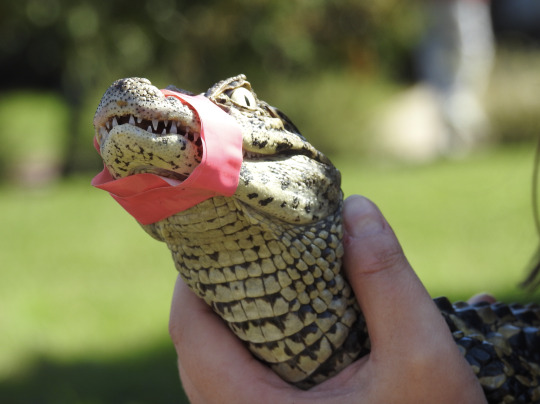
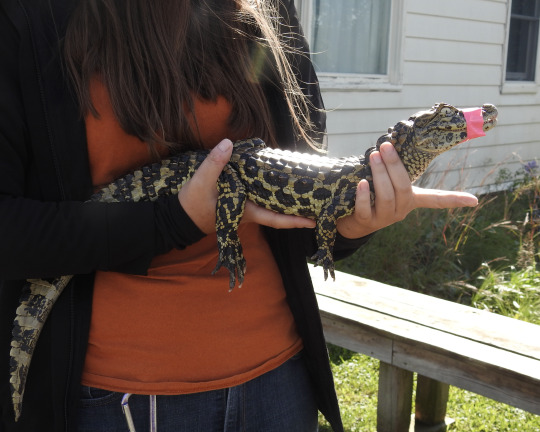
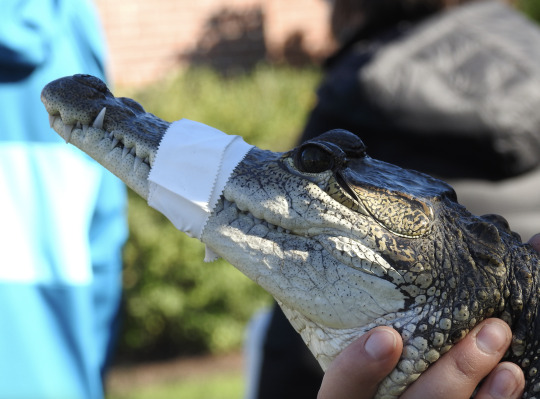
So when is tape not safe? When it's the wrong kind of tape. One of the worst offenders is duct tape.
When you're banding an alligator, you need to think about how sensitive their jaws are. A band that's too tight or too sticky can hurt them badly when it's removed- and you want that removal process to be fast, so that it doesn't stress them out too much.
What inspired this post was this picture I saw on Facebook:
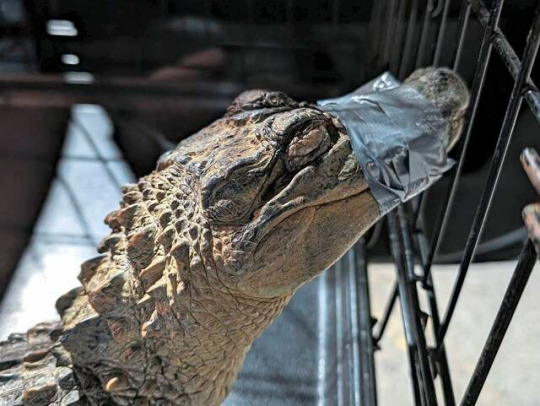
That's so much duct tape! Now, this little guy is quite unhealthy; he's been loose in the Pittsburgh area all winter, and he's been struggling. What you see here is a very quick tape job done as he's getting ready for transport. The article didn't say who taped him, but given that he's in a dog crate and was found by bicyclists, I would wager that it was some harried animal control officer who was doing the best they could. And that's fine because this was truly an emergency situation. In an emergency situation, uncomfortable is always, always better than unsafe.
But if you see a tourist attraction and they've put duct tape on their alligator's mouth? That's a red flag! Banding an alligator in public is the safe, correct thing to do- you just want to make sure that it's done right.
If you want more information about alligator jaws, here's some interesting papers to read:
Erickson, Gregory et al. Insights into the Ecology and Evolutionary Success of Crocodilians Revealed through Bite-Force and Tooth-Pressure Experimentation. PLoS ONE 7(3): e31781.
Knight, Kathryn. Croc Jaws More Sensitive Than Human Fingertips. Journal of Experimental Biology (2012) 215.
Sellers et al. Ontogeny of bite force in a validated biomechanical model of the American alligator. Journal of Experimental Biology (2017), 220.
665 notes
·
View notes
Text

it rains the creator
Hi! My name is Rayne Blakeman. I am an artist living in Pittsburgh, PA.
Welcome to my Creative Counseling landing page.
Connect Ask (Tumblr users only) Services Testimonials
Below, you will find some information about my background in creativity, my beliefs about creativity as a universal need, and my goals as a creative counselor.
Thank you for being here!!!
My background in creativity reaches far back into my youth, when I needed to be heard by someone, anyone. That someone ended up being myself, and I learned that I could express myself through art and music. I tuned in to the “little voice”, my child self that just wants to love and be loved and have fun. I would take songs I loved and change the lyrics to tell my story. I would draw little comics, my favorite characters from cartoons, and I’d draw what I imagined I would look like as a teen and an adult. Expression quickly became my best friend and the way that I would survive, and the way I could imagine a future for myself. What started as a coping mechanism became the greatest gift I would ever find. I kept listening to the little voice, and I kept choosing self expression again and again, through my art, my drawings, my words, my fashion, and my voice. I got a ukulele at age 12 and it became my favorite way to express my thoughts and feelings. If there wasn’t an outlet for my creativity to be shared, I would create one. I facilitated a talent show at my middle school just so I would have a chance to sing my songs on stage. Shortly after, I started playing local shows, and started building a foundation in my community in my town and online to share my songs and art with a larger audience. My first self-published music project was called Human Petting Zoo, and that project would go on to completely transform my life.
I carry this gift of creativity into my adulthood. I spend time writing every day, taking any preoccupied thought and getting it out, so I can let creativity flow through me with the least resistance. I am a singer and songwriter, playing many instruments and taking a liking to guitar in the last few years. I have done guest vocals on songs and albums of my friends and contemporaries. I (still) produce all of my own music and record it at home, DIY style, and distribute it myself. I am a seamstress, creating garments from my imagination or using patterns or clothes I already have to bring my ideas to life. I'm a visual and graphic artist, playing with Gimp (a photo manipulation program) and drawing with pens or colored pencils. I have taken an interest in interior design and decoration since buying a house two years ago, and have turned my office space into a haven for sacred creativity. I’ve designed a color palette and whimsical paint job for my friend’s coffee shop. I have been studying calligraphy and illuminated manuscripts, reading works by mystics of various spiritual backgrounds, learning about astrology, the human shadow, archetypes, working with tarot cards, and much more. I’ll play with whatever I can get my hands on to express myself and my unique (and in some ways universal) experience of being here.
Wherever the joy is, I follow it, and that is a creative decision I choose to make every day. I believe creativity is a key to transformation, and that creativity is a universal need. In an energetic ecosystem, each part of the ecosystem plays a vital role, just by being perfectly itself. A flower being a flower, a blade of grass being a blade of grass, a tree being a tree… You being yourself. These creative acts of authenticity bring life force into the larger whole.
I knew I had to become a creativity guide when I would hear friends make statements along the lines of, "Nothing I am making is good enough to share," or, "It's not worth the embarrassment," or, "It's not really art, I'm just a fake artist," or, "I could never make music again after what happened to me." Hearing these statements made my heart break. Whoever told them that their self expression wasn't good enough, that the way they related to the world was wrong or invalid, that they simply aren't creative, is just wrong, and probably blocked creatively themselves. Every single person, every single being, and the universe itself, is creative. Breathing is creative. And when I start to look at life through this lens, I see that even things like doing your taxes is creative, as rigid and soulless as it may seem, some people find their flames aglow from the process.
Anything can be creative if you let it flow within you, and then without you.
My main goal as a creative counselor is to guide people out of the darkness of "I'm not creative" and into the light of "I am creative, and I'm doing it right now". I will create a judgement-free space for others to be themselves unapologetically, to express things that they thought would be better left buried inside, to explore parts of themselves they might have overlooked or cast aside, and to experiment and play with possibilities never considered. Together, we will use discernment to find the paths that seem most interesting and exciting. We will learn together that our jobs as artists and creators is to create, not to judge our creations. A song is a song. In our shared experience of nurturing and recovering our creativity and finding the ways we have been blocked by past experience or by our own fears, we will both do a lot of growing and reflecting together. And so, part of my goal is to continue to grow as an artist myself through this practice. I view my life as an art project about becoming more free, and the goal of becoming more free is woven into everything I create and everyone I interact with.
Thank you for taking the time to read a bit about me. You will find more information about my services in the services page, located in the sidebar/top bar.
2 notes
·
View notes
Note
Do you have recommendations for what to do and see in Pittsburgh? And is it easy to get around by bus/subway etc?
anon I’m so sorry, I started replying to this at the airport on my way home then saved it to drafts and forgot to go back and publish, oops! anyway…
ok, please bear in mind I am just a person who has visited a few times so this is in no way exhaustive, and will obviously be coloured by how easy things are to get to without a car and things I personally find interesting!
presented in no particular order…
heinz history centre & sports museum
go for a wander through the strip district
fort pitt museum & point state park
national aviary (fun on its own but would thoroughly recommend the penguin encounter as an extra)
andy warhol museum
carnegie science centre (though I just went to a specific exhibit so I don’t actually know about the museum as a whole but I liked what I visited)
walk the three rivers heritage trail along the north shore & visit the mister rogers statue (and I always enjoy walking over one or other of the three sisters bridges to get across from downtown and back afterwards)
take a trip on the inclines (duquesne is the prettiest and has the best views of the city at the top but personally I like to go up the mon - when it’s not closed that is - walk along grandview then come back down via duquesne)
point of view sculpture (just a bit further along grandview from the duquesne incline)
pittsburgh has a couple of theatres so it’s always worth checking out what’s on during your trip, and pittsburgh has some great restaurants/bars to check out too.
also, not really a “thing to do” but I will never get tired of arriving via the fort pitt tunnel when coming in from the airport and downtown just explodes in front of you as you emerge!
there are some other places I haven’t visited yet but are on my list, including the zoo & aquarium, phipps conservatory, carnegie museums of art and natural history, the frick, and randyland.
on the second question, downtown & the areas close by are very walkable but I find it is pretty easy to get around on public transport, yes. PRT now has an app (ready2ride) that includes a journey planner and live trackers (amongst other stuff), lets you buy a range of different types of pass that you then use by just scanning your phone when you get on, and which covers buses, light rail and the inclines. as someone who lives in london and is used to just tapping my phone to travel on public transport, this was way easier for me than having to think about paying fares every time and took a lot of anxiety out of using buses!
the T (light rail) is also free between downtown and the north shore - all the stops between first avenue and allegheny - which is handy! I also think it’s neat that most bus stops have a QR code you can scan for live arrivals info, which also helps you check you’re at the right stop :)
#Anonymous#answers#sorry for the delay but here are some thoughts#for whatever it’s worth#wpa#I have a fear of getting on a bus going the wrong way#bc of traffic driving on the opposite side of the road than I’m used to#so the bus stop thing soothes the anxiety lol
8 notes
·
View notes
Text

Aardvark at the Zoo, 1977
A view of an aardvark from the Highland Park Zoo. More than 100 years ago, philanthropist Christopher Lyman Magee donated $125,000 for the construction of zoological gardens in Pittsburgh's Highland Park area. On June 14, 1898, the Pittsburgh Zoo opened to the public for the very first time, providing people with a rare glimpse of animals and plants they had never seen before. Fitting zoo paradigms of the time, it was more of an animal menagerie. Through the years, however, the zoo has transformed into a naturalistic habitat and resource for conservation, education and research.
Pittsburgh City Photographer Collection
University of Pittsburgh
Historic Pittsburgh
7 notes
·
View notes
Note
I saw you mentioned Queer As Folks recently. OMG how I missed Brian and Justin. When they went angst, they reeeeeaaaally served angst. I seriously don't have access to watch the entire series in my country, I can only watch snippets from youtube. I'm so sad 😭 Can you share with me what you like most about QaF and maybe if you have your favorite Ao3 fics about them. Thank you so much, Key ❤
Aaahhh, Anon!
You've unsurfaced some deep memories.
Okay, I just finished writing the thesis below. I'm back from the future. A lot of what you're about to read is pure emotion, so I apologize that it's not, uh. Well structured or especially rational. Queer as Folk was very formative for me, so my thoughts on it are very formless. \:D/
•
I watched Queer as Folk in high school, and it was a core experience. I vaguely remember writing Brian/Justin fic, but I think I mainly just read, and unfortunately, all of the fic I read was on LiveJournal, so I have no idea how to find it anymore. I'm really, really bad with names and titles, so I'd really only know them if I saw them again. :')
I have hot takes, though!
As far as fandom goes, the US version was phenomenal. So much fic. So much fic, and I loved it so much. The fanvids, the art, the meta, etc. It was such a great fandom.
BUT as a show, I preferred the UK version. I thought it was better crafted, the story and characters felt a lot stronger, and the dialogue was fantastic. It felt more inclusive in every way, and it had this…cozy warmth to it. Even at his worst, Stuart is nowhere near as much of a menace as Brian, and I think that's because he has Vince, and Brian has Michael.
(I didn't like Michael. At all. \:D/ The actor is lovely! I just regularly pined for the character to be pushed through a nineteenth floor window and then get stepped on by an elephant tourist visiting family at the Pittsburgh Zoo.)
The US version also screamed Written by White Cis Gay Men Who Held a Weird Grudge Against Lesbians and Didn't Believe Bisexuality Is Real. I was a "definitely straight except for that one time and that other time and that other other time I had suspiciously queer thoughts and also argued a shade too passionately about queer rights at the dinner table" teenager, and while I loved Brian and Justin as a ship, the UK version made me feel like I could find friends who'd feel like family one day. (And it came true, and they're queer, too.)
I think of the US version of Queer as Folk as fandom fodder. After every episode, I'd dive into LiveJournal, read fics, meta, look up fanvids, etc. I learned so much from Elder Queers who talked about safe sex and the importance of getting tested and all the things either referenced in the show or totally ignored that Elder Queers were like, "This was ignored but if you're ever in Justin's situation, here is what you do, please promise you'll do this."
The UK version is the one I rewatch when I want to revisit that warm, safe feeling.
And it'll always fuck my brain up that the US showrunners of Queer as Folk watched Stuart fuck a fifteen-year-old that was blatantly framed as "this is a bad thing, Stuart is doing a bad thing, everyone is aware that this is a bad thing, this is very bad, Stuart" and thought, "Okay, the bad thing is that he's fifteen, so let's age him up to seventeen and make him the love interest instead of the best friend who's the same age."
MIND. BLOWN.
I mean, it explains why Michael's all [evocative hand gestures]. His English counterpart actually ended up with his hot Irish best friend. And, like, Vince is obsessed with Dr. Who, so they gave Michael comic books? Like? Why not Star Trek? And he's obsessed with Brian and has the same soul-destroying crush that Vince has on Stuart, but there's a point to Vince's crush on Stuart the point is that they end up together and Nathan is a high school boy who is genuinely meant to be a blip on the radar in the background of their story.
It's been long enough that I don't hate Michael anymore, I'm just still fascinated by CowLip's bizarre story decisions.
Here's how I'll summarize my complicated relationship with the US version of Queer as Folk:
Season five was an insult to me personally, and I never watched the last episode. That stupid ending reversed all five seasons of Brian's character arc and landed him exactly where he was in the first episode, only multiple years older. And CowLip talked about it like it was brilliant and not a pathological misunderstanding of how storytelling is meant to operate to connect with audiences.
But.
I remember watching the Babylon bombing episode. Viscerally. I was staying at my sister's house, and I waited until everyone fell asleep. I snuck into their home office to watch the episode on their computer because I kept all queer media I watched secret from everyone in my very conservative family. I turned the volume down to one bar, kept the lights off, and held my shallow breath whenever the house made any kind of noise. Because Brian had never said "I love you" before, and this was it, because he thought Justin would be one of those corpses rolled out on a gurney from the club where they met, where their friends and family all gathered, the only place they felt safe being gay.
And many years later, when something similar happened far, far away at Pulse in Orlando, a memory surfaced of secretly watching an episode about love and desperation and grief. Of feeling caged inside a sexuality prescribed to me. And it was the first time I came out on social media.
Because it was a ridiculous show in some ways, and a terribly written one sometimes, but I think it also cut to the quick for many of us who just…didn't have anything else. We didn't have many options back then, and the fandom was massive, and it nudged me a little closer to understanding who I am and who I love.
#kiranokira answers#queer as folk#i just reread this and i've never felt more like i have adhd tattooed on every inch of me#i'm so sorry anon this show apparently comes with a word vomit button
15 notes
·
View notes
Photo








Donna: What are you bidding on? It better not be Terrence Howard's tank top from Hustle & Flow. Ann: It is not. Donna: Good. 'Cause I am bidding on it and I am ready to spend an amount that my accountant calls "dangerous and irresponsible."
Ann: JJ's diner put an old waffle iron up for auction. It's the perfect breakfast day gift for Leslie.
Donna: "Breakfast day"? Ann: Leslie has anniversaries for everything. "Zoo day," first time we went to the zoo together. "Double date day," it was the first time we went on a double date. "Daniel Day-Lewis day." "Talk-like-a-pirate day." "Talk-like-a-Pittsburgh-pirate day," which why and how? This calendar was last year's calendar day present celebrating the first time she ever bought me a calendar
8 notes
·
View notes
Text
Since I’ve gotten seen by some new people on here, I wanna say hi and share some info abt myself :) feat this gorg Picsart !!!
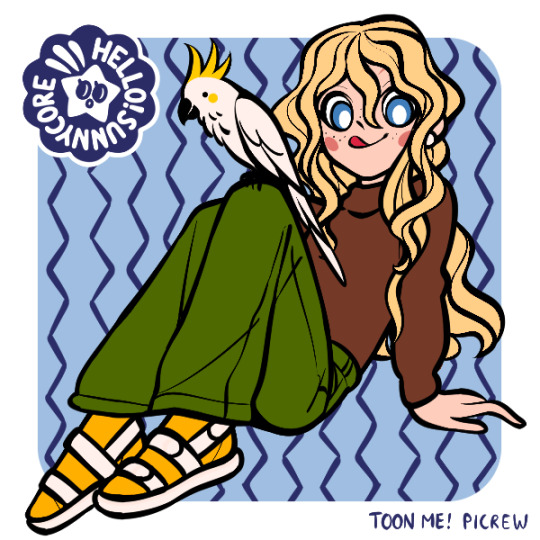
I’m an environmental science and ecology student focusing on wildlife conservation!! My dream job is to become a national parks or fisheries and wildlife ranger
I’m from the US!
Im a HUGE hockey fan (let’s go pens!!) and have played men’s hockey for most of my life
I LOVE birds- the birdie in the pics art is to represent my bff Ella, an umbrella cockatoo I work with a ton at my job (I work at a rescue zoo!)
My whole life I’ve always loved animals, and I’m so happy and excited to dedicate my whole existence to protecting them and educating people about them :)
My favorite color is yellow
My most favorite places in the whole world are Pittsburgh and Acadia National Park
I’m in a sorority and I love my sisters to the moon and back <3
Any free time I can possibly find I spend outdoors- hiking, drawing, painting, ect.
My fav animal that isn’t a bird is a bear, and my fav tree is a redwood :)
Kind of weird but it’s become a personality trait people associate with me- almost all my clothes are from LL Bean, mostly all hammy downs from my dad and extended family
#a lil about me!!!#I really love the outdoors if you can’t tell#also I’m a complete crunchy granola hippie#I literally have Brook trout chacos#like I am down horrific for Mother Earth
3 notes
·
View notes
Text
Submission, Domination, and the Conditions that Make One or the Other Desirable RE: Sexual Intercourse
youtube
Now when I was dating n' living w/ Grace Marston (mentioned in posts here and my other blogs) one gripe she had was that "we were both submissive." Grace sometimes had ideas, like in porn she saw where the AMAB put his foot on the AFAB's head during intercourse. She enjoyed being "spanked" n' "spanking" as well!
First off, I didn't mind humouring her "spanking" kink, but I did explain to her that it felt too stupid to me, like "slapstick." I preferred choking n' being choked, and we played various games involving tying ourselves to one another, etc.
I might've explained as well that I was more dominant towards one of my other exes, Lucy Zipple, in bed due to how we interacted outside of the bedroom! For example: Lucy was incredibly rude, direct, and mean, and she yelled at me quite often, sometimes as a joke!
Grace was mean sometimes too, but it was more like she was consistently condescending in a "stupid" way. Besides, when I got Grace in a decent mood or state of mind, I could see she had the potential to be a very sensitive, gentle person underneath. She didn't mind being submissive and kinda docile in public w/ me either, whereas Lucy was quite loud and animated when we were hanging out w/ friends! As I've written before, I believe Grace may've been somewhere on the autistic spectrum, whereas Lucy was quite neurotypical.
youtube
youtube
What's my excuse for this behaviour of mine?! Well I've thought abt it extensively, tbh, and I wasn't necessarily behaving that way consciously much of the time, this might've been something I figured out after the relationships were over!
Whatever the case, in my middle age, whenever a potential sexual relationship becomes relevant, I enjoy referring back to what I learned in my time exploring the "kink" community, their writings re: consent, etc, and then combining that knowledge w/ my personal experience, ethics, and politics to ensure everything goes smoothly in the future!
QUESTION 1: Was anya it ever noncensensual?!
TBH, no, but tbh I did try spanking Lucy in the middle of intercourse once and her response was "Did you just hit me?! You just HIT me!" It seemed more like surprise than anything lmao, but then again she oft seemed surprised during and after coitus! Funny story, I tricked her into acting domineering in bed once. I mean, no, I didn't trick her lmao, I just told her to shut up in the middle of sex and then her face suddenly got serious and she started saying stuff like "I hate you" in a cool way, and yes, we were still F'ing, it was pretty neat. I naturally dommed her in response, shutting HER up lmao if you know what I mean!
With Grace there was ONE time I pressured her into coitus when what she wanted to do was just give me a handjob or "beej" to help me sleep, but that's 'bout it.
to be continued maybe
youtube
Question 2: haha yes, when Lucy started saying "I fucking hate you" it seemed like she was getting into it, and her voice did, indeed, become lower and more "sultry." She started having sex with me kinda more passionately too! She never acted that way again and I figured she didn't have experience acting that way, it just "came outta her."
Question 3:


LMAO now I'm sure some, as usual, won't believe me but there is oft hentai of me n' my past sexual partners, as well as imagined partners, available on nhentai! Grace, for some reason, is a favoured subject and I've been informed that many AFABs simply draw or read their friends' hentai and imagine themselves as her, and that it's the only "sex life" they need at this point!
Some who may remember a previous facebook profile of mine, as well as Grace's socials, may recognize these scenes of us going out n' about in Pittsburgh as well as visiting the zoo and aquarium!
I mean, I personally don't mind so long as nobody takes it too far and turns everything into tasteless psychological attacks! I hear Grace herself enjoys looking at some of it too.
I had some more convincing evidence of the hentai, and some even including Lucy Zipple, me with a vag, me named "Elana" etc, which may be why some want to get the stories straight due to the hentai viewers or makers who take things too seriously or too far!
Besides, what am I gonna do to stop ya, eh!? Lmao!
Question 4:
Sure, I'd meet up with the hentai-makers, why not? Those've you recoiling at the idea: I know for a fact most've the hentai-makers n' consumers who do it tastefully're AFAB, which makes many feel better for some reason!
1 note
·
View note
Text
Journey To The 2023 Pittsburgh Zoo Asian Lantern Festival
In the evening of our Pittsburgh stop, we bought tickets to see the Pittsburgh Zoo Asian Lantern Festival. I was excited to see this–a few years ago Sam and I had gone to a sky lantern festival. The last time I went was in 2019–and during the day. On the drive to the zoo, there was a beautiful rainbow. Continue reading Journey To The 2023 Pittsburgh Zoo Asian Lantern Festival

View On WordPress
1 note
·
View note
Text





The Pittsburgh zoo and Aquarium Asian Lantern Festival
This was a very awesome experience. The Lanterns were amazing. It was cold and raining this particular day but still had a fascinating time. My boyfriend took our kids to see this and we had fun family time.
#art#photography#buildings#spitmag#art blog#artists on tumblr#facebook#photo#spitmag photography#poetry#asian fusion#asian festival#zoo#lights#lanterns#familytime#i love my family#i love my man#pittsburgh pa
1 note
·
View note
Text
we had a breakdown over some Unwholesome slutty sid content yesterday so here’s some wholesome content from the athletic on sid
It was 2016 in Minnesota and an aggravated coach Mike Sullivan was searching for the captain of the Pittsburgh Penguins following a loss to the Wild. Sullivan needed to speak with Sidney Crosby and was walking briskly on the event level of Xcel Energy Center.
Then, he stopped in his tracks.
Around the corner outside of the Penguins’ locker room, Crosby, minus his jersey but otherwise still wearing his equipment, was sitting on the floor. Speaking with a child in a wheelchair, Crosby sat so that he could better make eye contact. He often does this. Sullivan executed a U-turn while his captain sat with the child for 20 minutes, a scene that unfolds countless times across North America every season.
Thousands upon thousands of people have flocked to arenas for decades to watch Crosby play hockey since was a boy. Crosby’s greater mission, though, has always been to comfort the sick and unlucky among us with an uncommon grace and thoughtfulness that is uniquely his own.
“There’s never been anyone like him before,” former Penguins general manager Jim Rutherford said. “And there will never be anyone like him after.”
The widely held belief that the world of professional sports doesn’t showcase any authentic role models is inaccurate so long as Sidney Patrick Crosby walks among us.
“You always hear that saying,” Bobby Orr said. “You know, that so and so is a better person than he is a player. Well, the great thing about Sid is, he’s one of the five greatest players in history. There’s no question about that. But he actually is a better person than he is a player. Now, think about that. I love him.”
On the ice, he is a living legend. The massive legs, the impenetrable ability to protect the puck, the greatest backhand ever, the cannon-like burst of speed through the neutral zone, the rare playmaking ability, the tenacity, the intelligence, the determination, the precociousness as a teenager, the longevity as a thirty-something and the ability to score goals on hockey’s biggest stage are all indelible trademarks of his greatness.
The mythology of Crosby off the ice, however, may be even more worthy of inclusion in the history books and it is very much rooted in reality. He’s not just an ambassador for hockey, but an ambassador of kindness.
“He was like that even as a little boy,” said Troy Crosby, his father. “He was getting so much attention when he was little, and then as he became a teenager. It could have gone to his head. He could have gotten a big ego. All Sidney ever cared about was taking care of other people.”
Crosby made his NHL debut on Oct. 5, 2005, in New Jersey. It was a zoo after the morning skate. Hockey was back after a year-long lockout, Crosby’s debut was being made in the New York area against Hall of Fame goaltender Martin Brodeur and it was Mario Lemieux’s 40th birthday. While he was the center of attention, Crosby, who had turned 18 two months earlier, wasn’t concerned about himself.
“He was giving these interviews and there were people everywhere” said Tom McMillan, the former Penguins’ vice president of communications. “But he noticed, in the hallway outside of the locker room, that his mom was being surrounded by reporters. He was worried about her. She was fine, but he was worried about her. So he comes up to me and says, ‘Hey, can you make sure my mom is OK?’ From the very beginning, he was worried about everyone but himself. He never changed.”
Including his salary and endorsements, Crosby has earned in the neighborhood of $200 million in his career. His father isn’t the only one who says Crosby hasn’t changed. His teammates agree. Team employees agree. Even living legends like Orr agree.
There is a simple explanation for this, Crosby insists.
“I don’t think money ever gives you the vehicle to treat anyone differently or to be disrespectful,” he said. “I get to do what I love to do and I’m very appreciative of that. I don’t take that for granted one bit, regardless of what my pay is. I get to do what I love. The least I can do is treat people well along the way.”
Crosby’s legend in the Penguins organization is such that his contributions to society draw biblical comparisons.
Literally.
“I always say that he’s like a child of God,” former Penguins broadcaster Paul Steigerwald said. “That’s how I’ve always seen him. He has a certain light in his eyes that I always notice. He’s a genuinely good soul. People often give credit to a person’s parents for raising a great kid. I totally get that and they did a great job. But I also see a natural soulfulness to Sid that is innate and not necessarily learned.”
Crosby is a role model, and he knows it. He embraces it.
“I’ve been around a while and I’ve met a lot of people,” Rutherford said. “I’ve never met anyone like him. He only does things for the right reasons. And he cares about people so very much. Other players of his stature don’t always act like this. But he’s different. And you see it most when it comes to the way he treats children.”
The Penguins are the NHL’s oldest team, thus, many players have children. During the Stanley Cup years in 2016 and 2017, it was commonplace for Matt Cullen’s children to be hanging on Crosby after playoff wins, as they would naturally gravitate to the best player in the world who just happened to be the nicest guy in the room.
Crosby, in fact, has been known to have spirited mini-sticks games with Nikita Malkin. And yet, his treatment of children isn’t confined to the children of his teammates.
One story lives in Crosby lore.
It was Jan. 11, 2014. The Penguins had just won in Calgary, 2-1, in the weeks leading up to the 2014 Olympics in Sochi. After the game, the Penguins departed to their bus on a frigid Alberta evening.
While sitting on the bus, Crosby noticed a handful of teenagers standing behind a fence, which was located on a steep hill beside the Saddledome. They were chanting Crosby’s name and had signs wishing him well in the Olympics.
Upon seeing this, Crosby, dress shoes and all, sprinted up the steep, icy hill. He not only signed all of their jerseys but talked hockey with them for a few minutes before slowly coasting back down the hill.
“I’ll never forget seeing that,” Steigerwald said. “Who else does that?”
Not many people would do such a thing, it can be presumed. But Rutherford saw it every day while he was the general manager of the Penguins.
“The way he treats children is the single most impressive thing I’ve ever seen in my career,” Rutherford said. “When you see those groups of people who want autographs, you have to be careful. A lot of those groups have people that are there every day and looking to sell autographs. But I’ll tell you this about Sid: Never, not one time, has he ever passed by a child who wanted an autograph. No child is ever left behind. I’ve seen him sign autographs and then get on the team bus. Then, he sees a kid pop up who didn’t get his autograph signed. So, he always gets off the bus and makes sure the kid has an autograph and a picture with him. He understands the effect he has on people, but he’s the farthest thing from arrogant you could possibly imagine.”
Crosby is a regular at the UMPC Pittsburgh Children’s Hospital. While the Penguins do occasionally orchestrate team visits that Crosby naturally takes part in, he’s a regular at the hospital. He does so on his own time.
No cameras. No reporters. No attention.
“I’ll be honest with you,” Troy Crosby said. “That’s the way he wants it. It means a lot to him to spend time with kids, just him and the kids. He doesn’t want people knowing about it and he goes to lengths to keep it that way.”
Crosby seems miffed when others are blown away by his character. To him, to be polite, generous and thoughtful is simply natural.
“Treating people the right way has always been important to me,” Crosby said. “Whether it’s your teammates, people you see at the rink, fans, kids, whatever. You’re supposed to be good to people in life. You’re supposed to be respectful. So, that’s what I try to do every day. It’s always been a very important thing to me.”
444 notes
·
View notes
Text
NHL99: Sidney Crosby, icon of his era, never strays from his greater mission
It was 2016 in Minnesota and an aggravated coach Mike Sullivan was searching for the captain of the Pittsburgh Penguins following a loss to the Wild. Sullivan needed to speak with Sidney Crosby and was walking briskly on the event level of Xcel Energy Center.
Then, he stopped in his tracks.
Around the corner outside of the Penguins’ locker room, Crosby, minus his jersey but otherwise still wearing his equipment, was sitting on the floor. Speaking with a child in a wheelchair, Crosby sat so that he could better make eye contact. He often does this. Sullivan executed a U-turn while his captain sat with the child for 20 minutes, a scene that unfolds countless times across North America every season.
Thousands upon thousands of people have flocked to arenas for decades to watch Crosby play hockey since he was a boy. Crosby’s greater mission, though, has always been to comfort the sick and unlucky among us with an uncommon grace and thoughtfulness that is uniquely his own.
“There’s never been anyone like him before,” former Penguins general manager Jim Rutherford said. “And there will never be anyone like him after.”
The widely held belief that the world of professional sports doesn’t showcase any authentic role models is inaccurate so long as Sidney Patrick Crosby walks among us.
“You always hear that saying,” Bobby Orr said. “You know, that so and so is a better person than he is a player. Well, the great thing about Sid is, he’s one of the five greatest players in history. There’s no question about that. But he actually is a better person than he is a player. Now, think about that. I love him.”
At 35, Crosby is the hockey chief of the world, and he lands at No. 4 on The Athletic’s list of the greatest players of the modern era of the NHL. He has won three Stanley Cup championships, two Olympic gold medals, has registered 541 goals, 1,469 points and, quite remarkably, has lived up to every bit of the hype. His legacy is perfectly safe. He simply keeps going at this stage because he loves hockey and is obsessed with winning. Mike Babcock once called him a “serial winner,” which is the perfect description of Crosby. On and off the ice.
On the ice, he is a living legend. The massive legs, the impenetrable ability to protect the puck, the greatest backhand ever, the cannon-like burst of speed through the neutral zone, the rare playmaking ability, the tenacity, the intelligence, the determination, the precociousness as a teenager, the longevity as a thirty-something and the ability to score goals on hockey’s biggest stage are all indelible trademarks of his greatness.
The mythology of Crosby off the ice, however, may be even more worthy of inclusion in the history books and it is very much rooted in reality. He’s not just an ambassador for hockey, but an ambassador of kindness.
“He was like that even as a little boy,” said Troy Crosby, his father. “He was getting so much attention when he was little, and then as he became a teenager. It could have gone to his head. He could have gotten a big ego. All Sidney ever cared about was taking care of other people.”
It was evident from the very beginning.
Crosby made his NHL debut on Oct. 5, 2005, in New Jersey. It was a zoo after the morning skate. Hockey was back after a year-long lockout, Crosby’s debut was being made in the New York area against Hall of Fame goaltender Martin Brodeur and it was Mario Lemieux’s 40th birthday. While he was the center of attention, Crosby, who had turned 18 two months earlier, wasn’t concerned about himself.
“He was giving these interviews and there were people everywhere” said Tom McMillan, the former Penguins’ vice president of communications. “But he noticed, in the hallway outside of the locker room, that his mom was being surrounded by reporters. He was worried about her. She was fine, but he was worried about her. So he comes up to me and says, ‘Hey, can you make sure my mom is OK?’ From the very beginning, he was worried about everyone but himself. He never changed.”
Including his salary and endorsements, Crosby has earned in the neighborhood of $200 million in his career. His father isn’t the only one who says Crosby hasn’t changed. His teammates agree. Team employees agree. Even living legends like Orr agree.
There is a simple explanation for this, Crosby insists.
“I don’t think money ever gives you the vehicle to treat anyone differently or to be disrespectful,” he said. “I get to do what I love to do and I’m very appreciative of that. I don’t take that for granted one bit, regardless of what my pay is. I get to do what I love. The least I can do is treat people well along the way.”
Crosby’s legend in the Penguins organization is such that his contributions to society draw biblical comparisons.
Literally.
“I always say that he’s like a child of God,” former Penguins broadcaster Paul Steigerwald said. “That’s how I’ve always seen him. He has a certain light in his eyes that I always notice. He’s a genuinely good soul. People often give credit to a person’s parents for raising a great kid. I totally get that and they did a great job. But I also see a natural soulfulness to Sid that is innate and not necessarily learned.”
‘No child is ever left behind’ Charles Barkley once made considerable headlines for a Nike advertising campaign that stated, “I am not a role model.”
Crosby is a role model, and he knows it. He embraces it.
“I’ve been around a while and I’ve met a lot of people,” Rutherford said. “I’ve never met anyone like him. He only does things for the right reasons. And he cares about people so very much. Other players of his stature don’t always act like this. But he’s different. And you see it most when it comes to the way he treats children.”
The Penguins are the NHL’s oldest team, thus, many players have children. During the Stanley Cup years in 2016 and 2017, it was commonplace for Matt Cullen’s children to be hanging on Crosby after playoff wins, as they would naturally gravitate to the best player in the world who just happened to be the nicest guy in the room.
Crosby, in fact, has been known to have spirited mini-sticks games with Nikita Malkin. And yet, his treatment of children isn’t confined to the children of his teammates.
One story lives in Crosby lore.
It was Jan. 11, 2014. The Penguins had just won in Calgary, 2-1, in the weeks leading up to the 2014 Olympics in Sochi. After the game, the Penguins departed to their bus on a frigid Alberta evening.
While sitting on the bus, Crosby noticed a handful of teenagers standing behind a fence, which was located on a steep hill beside the Saddledome. They were chanting Crosby’s name and had signs wishing him well in the Olympics.
Upon seeing this, Crosby, dress shoes and all, sprinted up the steep, icy hill. He not only signed all of their jerseys but talked hockey with them for a few minutes before slowly coasting back down the hill.
“I’ll never forget seeing that,” Steigerwald said. “Who else does that?”
Not many people would do such a thing, it can be presumed. But Rutherford saw it every day while he was the general manager of the Penguins.
“The way he treats children is the single most impressive thing I’ve ever seen in my career,” Rutherford said. “When you see those groups of people who want autographs, you have to be careful. A lot of those groups have people that are there every day and looking to sell autographs. But I’ll tell you this about Sid: Never, not one time, has he ever passed by a child who wanted an autograph. No child is ever left behind. I’ve seen him sign autographs and then get on the team bus. Then, he sees a kid pop up who didn’t get his autograph signed. So, he always gets off the bus and makes sure the kid has an autograph and a picture with him. He understands the effect he has on people, but he’s the farthest thing from arrogant you could possibly imagine.”
Crosby is a regular at the UMPC Pittsburgh Children’s Hospital. While the Penguins do occasionally orchestrate team visits that Crosby naturally takes part in, he’s a regular at the hospital. He does so on his own time.
No cameras. No reporters. No attention.
“I’ll be honest with you,” Troy Crosby said. “That’s the way he wants it. It means a lot to him to spend time with kids, just him and the kids. He doesn’t want people knowing about it and he goes to lengths to keep it that way.”
Crosby seems miffed when others are blown away by his character. To him, to be polite, generous and thoughtful is simply natural.
“Treating people the right way has always been important to me,” Crosby said. “Whether it’s your teammates, people you see at the rink, fans, kids, whatever. You’re supposed to be good to people in life. You’re supposed to be respectful. So, that’s what I try to do every day. It’s always been a very important thing to me.”
On May 31, 2007, the Penguins made Crosby, then 19, the youngest captain in NHL history at that time.
The move seemed simple on the surface. He already had become the world’s greatest player and, as a teenager, had just claimed the Hart and Art Ross trophies. His maturity level was uncommonly advanced. He was already a rock star in Pittsburgh.
Easy choice, right?
“Not necessarily,” Crosby said. “It was quite uncomfortable, to be honest. I had never been a captain before.”
Say what?
Well, it makes sense. Crosby was only 16 and 17 when he played his junior hockey in Rimouski. In his younger days of hockey, he always played in older age groups because of his advanced performance. This was very much a new experience for him.
“I tried to learn things from other captains I had in the past and other people who had been captains,” he said. “But at the same time, I wanted to be my own person. I wanted to lead in a way that was natural to me. And you never stop learning. I’m still learning to be a captain to this day, honestly. But I think it was probably a good thing for me, looking back. It helped me grow.”
So did the presence of a fellow icon in the locker room.
Lemieux and Crosby played together in only 26 games before a heart condition forced the oft-injured Lemieux to finally retire for good. On the ice, they only had a few magical moments together, as they rarely played on the same line. Lemieux was slowing down and at the very end.
But before he left, he taught Crosby a few lessons.
“More than anything, he taught me how to stay calm. He was so, so even keeled,” Crosby said. “It didn’t matter what the score was, good or bad. Mario was always the same. He always looked the same, spoke the same. I watched him a lot and I saw how level-headed he was. I think that probably comes to him more naturally than it does to me. I’m probably more emotional than he is. I’m an emotional player. But he taught me how to find that sweet spot. Getting to play with him for a handful of games was a big deal for me.”
Crosby, many will tell you, is the best captain they’ve ever had.
“He’s unreal,” said one of the newest Penguins, Ryan Poehling. “When I got traded to Pittsburgh last summer, I had a text from him a couple of hours after the deal. I remember thinking that it was pretty incredible that Sidney Crosby is reaching out to me that quickly. Then you get to know him, and you immediately realize that this is a special person, that he’s different than anyone else. You can’t fake it. You’re born with what he has, the way he treats people.”
Nowadays, it’s understandable that young players would place Crosby on a pedestal. He’s not only one of the greatest players of all time, but he also treats them as equals.
What might be more noteworthy is that, even when Crosby was essentially a child, he had the respect of his locker room from the beginning.
“He was 22 when I signed in Pittsburgh,” Mike Rupp said. “He’s the best player in the world, this hotshot that everyone is talking about. I had absolutely no idea what to expect. … I could tell you so many nice stories about Sidney Crosby, and they’re all true. But what I realized right away was that, more than anything, Sid didn’t want to be treated differently than anyone else.
Given who he is, Crosby can’t possibly be one of the guys. It doesn’t work that way. He’s Crosby.
And yet, he is one of the guys.
“He just wanted to have fun. Wanted to play mini-golf on the road. He had that little kid smile. He wanted to play the handheld video games on planes,” Rupp said. “He likes to be one of the guys. I think what I’m saying is, he’s not a nerd. He’s not an introvert. But he wants nothing to do with the spotlight because he’s so damn humble. He’s the ultimate captain.”
When you’re a superstar in Pittsburgh, you have certain privileges. Lemieux and Jagr had their share of coaches fired. Some were certainly deserving, of course. But Crosby would never do such a thing. It simply isn’t his way.
He doesn’t demand his friends play with the Penguins. This, in no way, is a typical superstar.
“I was Sid’s GM for a long time,” Rutherford said. “And I can tell you, he never once complained to me about anything. He never once told me to fire anyone, or to trade anyone, or to get anyone in a trade. Never.”
Not until he was asked, anyway.
“Here’s how much respect I have for Sid,” Rutherford said. “At the end of each season, whether we had won the Cup or not, he and I would get together. I wanted his thoughts on certain players on the team and around the league. But he’d never tell me to get someone. He’d never be pushy or demanding. I’d ask him questions about people, and he would answer in his own very polite, very special way. That’s just the kind of man he is.”
Those who coached Crosby often had similar stories.
“He was a dream to coach,” Recchi said. “His relationship with Sully, you know, it’s really special. Those two have a bond. But for all of us on the staff, it was incredible coaching Sid. He asks you lots of questions. He wants your opinion. He’s not going to walk into your office and tell you what to do, or tell you what’s wrong. He asks so many questions and he loves feedback. Not many stars are going to be quite like that.”
Crosby has stated that he’d like to play for a few more seasons, perhaps until he is 40.
It’s unknown precisely when he will walk away or what he will do with his life once he hangs up his skates. Many in the hockey world hope Crosby will remain involved with the NHL in some capacity.
The hockey world, after all, couldn’t possibly be the same without him.
“He just makes you smile when you see him,” Rupp said.
Crosby entered our lives more than two decades ago, a child then. A man now.
A very, very good man.
“He’s just a nice person,” Steigerwald said. “A nice, nice person. The best of the best.”
31 notes
·
View notes
Text
Today's Black History Month illustration is of Henry Ossawa Tanner (1859-1937), the first Black painter to gain international acclaim for his depiction of landscapes and biblical themes.

Tanner was born in 1859 in Pittsburgh, Pennsylvania. He was the first of nine children born to Sarah Elizabeth Miller, a formerly enslaved woman who escaped her enslavers via the Underground Railroad, and Benjamin Tucker Tanner, an African Methodist Episcopal (AME) Bishop.
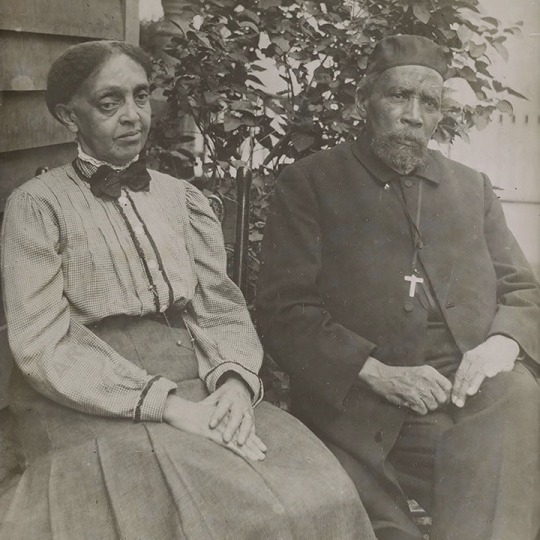
His middle name comes from the town Osawatomie, Kansas, where the abolitionist John Brown started his anti-slavery campaign.
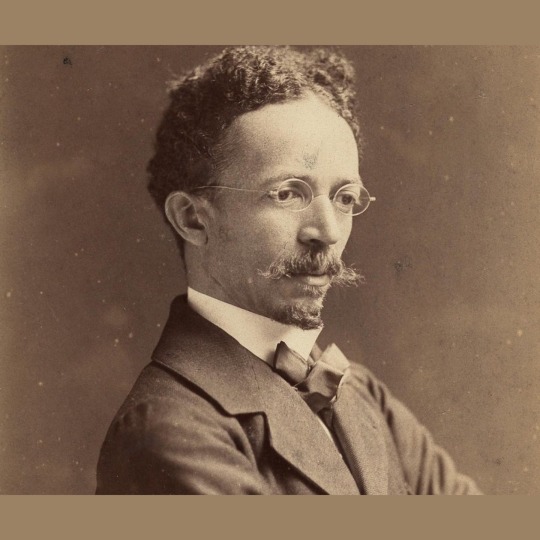
When Tanner was young, the Tanner family moved to Philadelphia. While in Philly, he attended the Robert Vaux School, one of the few Black schools that offered a liberal arts education. Despite his father objecting, Tanner decided he wanted to become a painter when he was 13. He began his art career in 1876 by painting harbour scenes, landscapes, and animals from the Philadelphia Zoo.
After self-study, in 1880, he enrolled at Philadelphia’s prestigious Pennsylvania Academy of the Fine Arts (PAFA) where he was the only black student. Tanner made many connections among the artists and became a favorite of his teacher Thomas Eakins, one of the most important artists in American art history.
In 1888, Tanner secured a teaching position at Clark University in Atlanta with the help of Joseph C. Hartzell, a bishop from Cincinnati, Ohio. In 1890, Hartzell arranged an exhibition of Tanner’s works in Cincinnati, but when none of the paintings sold, Hartzell purchased Tanner’s entire collection.
The money from Hartzell’s purchase allowed Tanner to travel to Paris in 1891 and enroll at the Academy Julian. During this time, he made Paris home because he felt less affected by prejudice.

His greatest early work depicted Black people and tender moments. His most famous painting, “The Banjo Lesson” where an older man was teaching a young boy how to play the banjo was created while visiting family in Philly in 1893.

By 1894, his paintings were critically admired in the US and in Europe. In 1899, he created one of his most famous works, “Nicodemus Visiting Jesus,” which won PAFA’s Lippincott Prize in 1900. Through the rest of his life, he shifted focus to religious scenes and continued to receive praise and honors for his work.


He was named honorary chevalier of the Order of Legion Honor (France’s most distinguished award) in 1923. In 1927, Tanner was made a full academician of the National Academy of design, becoming the first Black person to receive the distinction.

After Tanner’s death in Paris in 1937, his name recognition declined until 1969 when the Smithsonian in Washington DC exhibited a few of his works. This exhibition was the first major solo exhibition of a Black artist in the United States.

In 1991, the Philadelphia Museum of Art assembled a touring exhibition of his work, sparking a new wave of interest.

Side note: The Tanner House is on 2908 W Diamond St in North Philadelphia (Strawberry Mansion). It gained recognition as a National Historic Landmark in 1976, but it fell into disrepair. They’re still trying to find a long-term non-profit steward, but the temporary local fiduciary is the Preservation Alliance for Greater Philadelphia. To donate to the Tanner House Campaign, reach out to the Preservation Alliance.
I’ll be back on Monday with another illustration and story!
#henry ossawa tanner#black painters#black paintings#black history month 2023#black history 365#black history facts#artists on tumblr#illustrators on tumblr
25 notes
·
View notes
Text






Sungchan, 21
Rapper
Lives in Pittsburgh, PA
I'm really just open to anything really, Just looking for something to do. I have a lot of free time so we can go to the zoo, museum, take a walk in the park just anything to keep myself busy and hang out with new people.
Virgo ENTP

19 notes
·
View notes